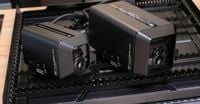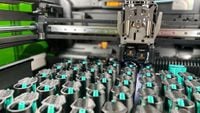Shenzhen-based Bambu Lab has made waves in the 3D printing industry with the launch of its new H2D 3D printer, unveiled on March 25, 2025. This highly anticipated device is not just another addition to their lineup; it represents a significant leap in personal manufacturing technology, combining advanced 3D printing capabilities with laser cutting, engraving, and digital plotting functionalities.
The H2D printer boasts an impressive build volume of 350 x 320 x 325 mm, making it Bambu Lab's largest model to date. This model features a dual-nozzle setup that allows for flexible printing techniques, enabling users to deploy multiple materials without the hassle of switching filaments frequently. Such convenience vastly improves efficiency, especially for projects requiring different filament types, including carbon and glass fiber-reinforced materials.
One of the standout features of the H2D is its advanced Automated Material System (AMS), which includes the new AMS 2 Pro. This upgraded system incorporates innovative mechanisms for filament drying, maintaining optimal conditions for material integrity through built-in heaters and electromagnetically activated vents. The AMS Pro can maintain filament temperatures up to 65°C, while another variant, the AMS HT, is designed for engineering-grade applications and can dry materials up to 85°C.
Bambu Lab’s CEO, Dr. Ye Tao, emphasized the company's vision for the H2D, stating, "The H2D represents the culmination of our vision to fundamentally transform how designers, engineers, and makers approach personal manufacturing." This declaration highlights the considerable advancements integrated into the H2D, which claims to offer proficiency resembling dedicated machines across various functions.
The H2D is not just a conventional 3D printer; it positions itself as an all-in-one manufacturing hub. The device is equipped with a laser engraving and cutting capability, featuring two laser power options: a standard 10W laser, which can cut materials like Basswood plywood up to 5mm thick, and a powerful 40W laser capable of handling up to 15mm. Additionally, the printer supports digital cutting, enabling users to work with materials like vinyl and paper, further enhancing its multifunctionality.
With varying prices between $1,899 and $3,499, depending on configuration, Bambu Lab offers several models tailored to different user needs. The entry-level H2D starts at $1,899 and will be available for general order starting June 2025. The H2D AMS Combo is in stock and ready for immediate shipping for $2,199, while the laser-enabled full combos can be pre-ordered for delivery by the end of April 2025.
Bambu Lab’s H2D utilizes a proprietary DynaSense Extruder with a Permanent Magnet Synchronous Motor (PMSM). This setup not only enhances motion accuracy—reportedly achieving up to 50µm precision across the entire build volume—but also mitigates issues long associated with dual-nozzle systems. Enhancements like live extrusion pressure monitoring and automated clog detection position the H2D among the most advanced options available to makers today.
Moreover, the design also caters to usability, featuring intuitive tool swaps between nozzles, lasers, and cutters with minimal physical intervention needed from the user. This feature streamlines project transitions, allowing users to shift from one function to another seamlessly.
Regarding user experiences, tech reviewers have already begun testing the H2D. James Bricknell from CNET noted that the H2D handles 3D printing outstandingly well, performing effectively with minimal failures and showcasing the expansive build area potential. He underscored how the dual nozzle setup operates successfully, allowing various materials to be utilized, enhancing creative possibilities for users.
With high-speed operations, the H2D can achieve impressive print speeds of up to 1000 mm/s and an acceleration of 20,000 mm/s². Such capabilities promise not only faster production times but also significant reliability when printing extensive projects alongside more intricate designs. The H2D is touted as an ideal machine for prototyping, educational purposes, and small business endeavors.
However, some critics caution that while the H2D offers impressive specifications, there are potential pitfalls regarding workflow management—especially when dealing with more complex or advanced materials. As seen in tests, workflow interruptions due to AI monitoring systems triggered by minor complications can be frustrating, suggesting a need for continued fine-tuning by Bambu Lab.
In conclusion, the Bambu Lab H2D is set to transform personal manufacturing by offering a unique blend of 3D printing and cutting-edge multimedia functionalities. Its emphasis on precision, ease of use, and versatility makes it a compelling choice for makers looking to consolidate their workspace while enhancing their creative capabilities.









